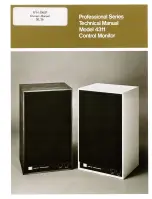
DE
DANIELS
ELECTRONICS
VT-3H040 VHF Enhanced Transmitter Instruction Manual
2-3
transmitter. Moreover, the surface of the Amplifier module that contacts the shell should be clean
and free of foreign material. The enclosure is completed by the installation of front and rear
plates which are fastened to the Transmitter Main Board (see Transmitter Main Board Manual
for parts lists).
Transmitter alignment is performed on a module by module basis and detailed steps are provided
in the respective manuals. Alignment is simplified by using an SR-3 Sub rack, SM-3 System
Monitor, and RF extender cable to provide transmitter power and signal interconnection.
Alternatively, +9.5 Vdc and +13.8 Vdc, as well as any required test signals, may be applied
directly to the individual modules. Refer to the corresponding manuals for details.
2.3.1
Complete Transmitter Alignment
A complete Transmitter Alignment is performed at the factory and should not be required under
normal circumstances. A large change in operating frequency, as discussed in the next section,
may require a complete realignment operation. This operation requires that all the transmitter
modules be aligned on a per module basis in the following order.
Sequence
Module
Manual Reference
(1)
Transmitter Main Board
Section 2.2 of this manual,
Transmitter Main Board Manual.
(2)
Synthesizer
Synthesizer Manual
(3)
Amplifier
Amplifier Manual
(4)
Audio Processor
Transmitter Main Board Manual
2.3.2
Frequency Change
The transmitter is initially aligned at the factory for the frequency stamped on the 'Factory Set
Operating Frequency' label (see section 3.1). This label should list the frequency at which the last
complete transmitter alignment was performed. For a small frequency change, a simple channel
change (see section 2.2) may be all that is required. A larger frequency change may involve the
realignment of other modules. The frequency change in question is the
accumulated frequency
change
in relation to the frequency stamped on the label. For example, if the frequency is
changed by 0.5 MHz from that stamped on the label, then a second frequency change of 1 MHz
in the same direction would result in a total change of 1.5 MHz. The action taken would be on
the basis of the 1.5 MHz value. Failure to perform a realignment after a large frequency change
could result in unreliable transmitter operation or transmitter operation that does not conform to
the published specifications. The allowable frequency change is summarized below.
Note: It is advisable to confirm these frequency ranges with the individual module manuals,
notably the amplifier and synthesizer, as they are subject to change with updated versions.
The values in the module manuals take precedent over those tabulated (following page).































